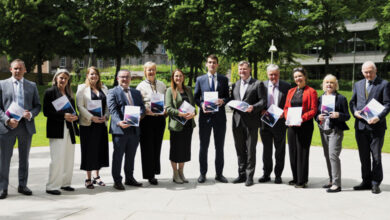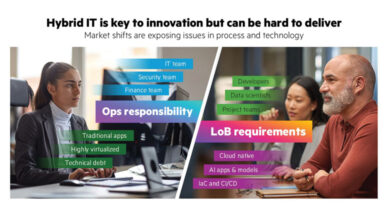Harnessing AI: A positive and transformative force for Ireland

Ireland is well positioned to harness the potential of artificial intelligence (AI). Minister of State with responsibility for Trade Promotion, Digital and Company Regulation at the Department of Enterprise, Trade and Employment, Robert Troy TD writes.
When we talk about AI, there is a tendency to speak in terms of the future or in potential and opportunity. We talk about what AI can help us to achieve and what it will do for us, but the fact is that many Irish businesses are already using and benefitting from AI, whether it is to improve productivity, to interact with their customers or to gain a better understanding of market opportunities.
AI is changing the way we work and live, opening up new ways to address problems in almost every field of human activity. It is when we recognise it as a tool for the present that its true potential can be realised: to help us as we drive toward a society and economy that is greener, more productive, and more innovative. To get there, though, we need to create the right conditions for the use of AI here and now.
In July 2021, the Government launched the National AI Strategy, AI: Here for Good, to provide high-level direction to the design, development, deployment, and governance of AI in Ireland. The strategy reflects our ambition to harness AI as a positive and transformative force for Ireland.
We want to support more businesses to benefit from AI and to help those businesses already using AI to achieve more sustainable growth through trustworthy systems. We will do this by building on Ireland’s existing capabilities, our thriving community of indigenous SMEs, and the presence of world-leading software and ICT industries.
In an effort to boost the uptake of digital technology, including AI, we have established a Digital Transition Fund. This €85 million multiannual fund will run until 2026 as part of Ireland’s National Recovery and Resilience Plan. This funding will help businesses as they work to become more productive, to develop new business models, and expand into new markets.
As an enterprise ecosystem, Ireland is already well positioned to harness the potential offered by AI. Many of the largest technology companies have an established presence here, we have an agile and highly skilled workforce, a record of scientific excellence, and a strong drive for innovation.
To further help our SMEs as they look to the opportunities offered by AI and other digital technologies, the Government has committed to establishing several European Digital Innovation Hubs (EDIH), which will offer upskilling, innovation and advisory services to enterprises and public authorities in areas aligned to AI, as well as offering technical expertise, research facilities, and experimentation.
“The Government’s vision is for Ireland to become a leading country in the use of AI…”
— Minister of State Robert Troy TD
At the core of each EDIH will be a research and technology organisation, or a higher education institution lab. These hubs will serve as the first stop for businesses looking to implement AI and other digital technologies. They will also serve as SME incubators, offering access to infrastructure, technologies, and test beds.
While all the EDIHs will engage with SMEs and help them as they adopt AI, one will be specifically designated the National AI Digital Innovation Hub. This hub will serve as the national first stop for AI, acting as a point of contact for businesses as they engage with AI adoption and the broader AI innovation ecosystem.
We are also working to assemble an Enterprise Digital Advisory Forum (EDAF), which I will chair. This forum will comprise representatives of enterprise – both large and small – AI experts, academics, and state bodies. It will work with government to drive enterprise adoption of AI and other digital technologies.
As with all new technologies, there is a degree of risk involved in the implementation of AI, and it is important we be cognisant of those risks. While it is true AI has unique potential to help us further our ambitions as a society, we must temper those ambitions with an awareness of the potential ethical implications of the deployment of AI.
The Government’s vision is for Ireland to become a leading country in the use of AI to benefit our citizens through a people-centred and ethical approach to AI adoption and use. The National AI Strategy will serve as a roadmap as we work towards that goal, adopting AI to the benefit of business and society in an inclusive and responsible manner.
Ultimately, if AI is to be truly inclusive and have a positive impact on all of us, we need to be clear on its role in society and ensure trust in AI is the ultimate marker of its success. To facilitate this, the National AI Strategy is underpinned by three core principles: the adoption of a human-centric approach to AI; staying open and adaptable to new innovations; and ensuring good governance to build trust and confidence so that innovation can flourish.
By making human rights and ethical principles a key focus of the National AI Strategy, Ireland is making a commitment to ensuring AI-based systems and solutions developed and used here are trustworthy, fair, and inclusive. Founded on these core principles, it is our ambition that we can put Ireland at the very forefront of a people-centred, ethical, and responsible rollout of AI.
The Government will also appoint an AI Ambassador to promote awareness among the public and businesses of the potential AI has to offer, serving as a champion of AI as a positive force for the economy and for society as a whole, emphasising an ethical approach. To inform the work of the AI Ambassador, we will soon begin discussions on young people’s attitudes to, concerns about, and visions for an AI-powered future using Comhairle na nÓg, the national structure for consultation with young people.
AI can help us to address long-standing challenges in areas like public health, education, housing, and urban development, to name just a few. While government has a role to play in facilitating and enabling the use of AI for the public good, this is a journey that will involve all of us, as a society.
Ireland can become a leading international hub for the ethical and responsible use of AI, and we all stand to benefit from that.





